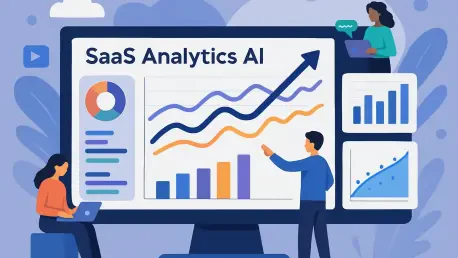In today’s rapidly evolving technological landscape, software as a service (SaaS) companies constantly seek innovative ways to differentiate and thrive. The release of Qrvey 9.1 marks a decisive chapter in this evolution, presenting a robust paradigm shift for embedded analytics. As data-driven decisions become paramount and organizations lean heavily on analytics for competitive advantages, Qrvey 9.1 meets these pressing demands head-on with features that aim to simplify and enhance analytics for SaaS platforms. By positioning itself as a pioneer in multi-tenant embedded analytics, the latest version challenges conventional norms, providing a sophisticated yet user-friendly approach designed to elevate SaaS analytical capabilities profoundly.
Bridging the Gap with Advanced AI
Qrvey 9.1 introduces groundbreaking advancements in artificial intelligence that go beyond the realm of traditional natural language queries. By interpreting complex user inquiries like “sales trends over time,” the software autonomously generates visual representations, providing clarity and logic without requiring user intervention. This evolution signifies a notable advancement in autonomous analytics, reflecting Qrvey’s commitment to delivering deep insights with unmatched ease. The intelligent automation of such complex tasks not only reduces the need for technical expertise but also democratizes data analysis, empowering end-users to make informed decisions swiftly and confidently. This development positions Qrvey as not just a tool but an agentic partner for SaaS businesses aiming to leverage analytics without substantial overheads.
The strategic introduction of advanced AI transforms how SaaS companies handle data analytics, offering a refreshing blend of simplicity and power. This capability ensures that companies can quickly respond to market dynamics while maintaining agility in data interpretation and visualization. As the AI autonomously processes complex queries, companies can focus their energies on strategic initiatives rather than intricate data management tasks. Such autonomy in analytics fuels innovation by accelerating insights and fostering an environment where businesses can experiment with and adapt their strategies with ease. Consequently, Qrvey 9.1 doesn’t just enhance analytical capabilities; it revolutionizes how SaaS teams interact with their data ecosystems, aligning business objectives more closely with data-driven insights.
Facilitating Rapid Deployment and Integration
The release of Qrvey 9.1 further advances its revolutionary status with customized packaging solutions aimed at expediting deployment and integration. Introduced with this version are Qrvey Pro and Qrvey Ultra, specifically crafted to cater to varying organizational needs. For teams with pre-existing analytics-ready databases, Qrvey Pro offers a seamless deployment process by providing embedded dashboards and automation without necessitating the incorporation of additional data engines. This packaging fosters an efficient and swift adoption, significantly reducing time to market for SaaS companies eager to integrate sophisticated analytics into their offerings.
In contrast, the Qrvey Ultra package provides a comprehensive full-stack solution with an integrated data engine, emphasizing flexibility and control for teams that require a tailored approach. This packaging is ideal for organizations seeking nuanced analytical capabilities and robust customization options. These targeted solutions ensure that organizations can implement and derive value from Qrvey 9.1, irrespective of their existing technical landscape or future aspirations. Complementing these packages, the software enhances its cloud-native connectivity, extending live connectivity to a wide array of platforms like SQL Server, alongside existing support for PostgreSQL, Redshift, Databricks, and Snowflake. This ensures that businesses can integrate seamlessly with existing analytic databases, highlighting Qrvey’s unparalleled commitment to supporting diverse modern data architectures.
Empowering Users with Self-Service Analytics
Another cornerstone of Qrvey 9.1’s appeal lies in its robust self-service capabilities, designed to empower users and diminish reliance on technical support teams. By allowing end-users to delve into data exploration independently, SaaS companies can streamline processes and foster an environment of increased autonomy in data-driven decision-making. Users are now equipped to build dashboards, unearth insights, and navigate through complex data structures with relative ease, a feat that significantly enhances user satisfaction and operational efficiency.
This focus on self-service analytics aligns with current industry trends, where increased user autonomy is crucial for optimal data utilization. By facilitating a platform where users can explore and analyze data on their terms, Qrvey 9.1 fulfills the wider market demand for intuitive analytics solutions that do not compromise on power or accessibility. This strategic approach not only enhances the overall user experience but also amplifies the potential for SaaS companies to extract value from their data, fostering a culture of informed decision-making that is both innovative and responsive to market needs. Empowering users with such tools is not merely a feature—it is a transformative shift towards more user-centric, agile, and data-driven organizational models.
Setting a New Standard in SaaS Analytics
In the swiftly changing realm of technology, software as a service (SaaS) companies are continually searching for innovative strategies to stand out and succeed. The unveiling of Qrvey 9.1 represents a pivotal moment in this evolution, heralding a robust shift in embedded analytics. As data-driven decision-making becomes crucial, organizations increasingly rely on analytics for gaining a competitive edge. Qrvey 9.1 directly addresses these urgent needs, offering features designed to streamline and enhance analytics within SaaS platforms. By positioning itself at the forefront of multi-tenant embedded analytics, this latest version challenges traditional frameworks. It provides a refined and user-friendly approach intended to significantly boost analytical capabilities for SaaS enterprises. The software’s ability to integrate seamlessly within existing systems underlines its role as not just a tool, but a catalyst for transformative growth, empowering businesses to leverage data in more meaningful, actionable ways.









